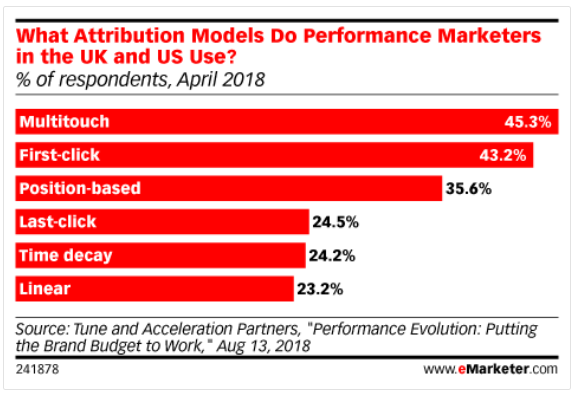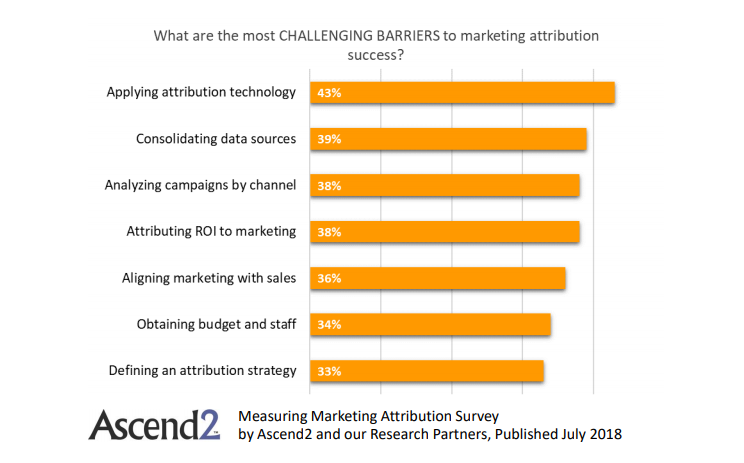Posted by: ClickZ
Posted on: 4/24/2019
A study by eMarketer last year found that 67.7% of US and UK marketers are still using last-click or first-click models to measure conversion points.
And there may be some purchases where the buyer knows exactly what he or she is looking for, strides confidently into a store (or clicks confidently on an item online), and makes a purchase within a matter of seconds. But that kind of quick sale is honestly pretty rare.
According to the Online Marketing Institute, most people need as many as seven nudges before they’re likely to become customers.
Most customers are eager to do their homework before making a purchase by interacting with multiple pieces of content rather than interacting with a single touchpoint and converting on the spot.
And if customers are encountering your brand multiple times across channels and devices before buying, it doesn’t make a whole lot of sense to attribute their entire behavior on the last piece of content they clicked.
However, way too many marketers are doing exactly that — but there’s absolutely a better way.
Content produced in collaboration with Fospha.
Last-click attribution only gives part of the picture
The last-click model of attribution gives all of the credit to the very last touchpoint in the customer journey.
However, by failing to acknowledge the fact that most of your customers are interacting with many touchpoints before conversion, last-click attribution gives a very inaccurate picture of customer behavior. This incomplete picture can mean sinking major marketing dollars into channels that don’t actually work as well as they appear to on paper.
Marketers spend big bucks on incomplete data
According to recent research by Fospha and ClickZ, wasting money on channels that aren’t really converting as well as they appear to be is a bigger problem than most of us realize. The survey found that nearly half of brands agree that they base digital strategy on insights from marketing intelligence platforms.
Yet, more than 30% listed each “data complexity” and “difficulty proving the ROI of attribution” as the two biggest obstacles to more effective usage of marketing intelligence technology at their organization.
That could be because brands aren’t getting a full picture of which touchpoints are converting.
Multi-touch attribution offers a better way
A 2018 survey by Ascend2 found that 43% of marketers found applying attribution technology challenging, while 38% also struggled to analyze their campaigns by the channels used.
By using multi-touch attribution (MTA) models, marketers can make better sense of their customer journeys and improve the effectiveness of their campaigns by allocating budget to the better performing channels.
Instead of focusing all your brands’ attention (and marketing budget) on that last click, MTA models weigh each individual touchpoint in the customer journey. So, if a buyer clicked a search ad that led them to a website, gave their customer data on a form, but converted after being targeted on social, multi-touch attribution will account for all, not just one, of those touchpoints.
Case in point: Moving from last-click to multi-touch attribution saved one company more than $250,000 in Google Ads spend
When professional e-learning company AVADO struggled to understand their customers using a last-click model, the company partnered with Fospha to move to an MTA model. Fospha was able to pull all hits from the company’s website into the customer data platform and stitch touchpoints to a single user, as well as layer cost data from their CRM system and apply multi-touch attribution algorithms.
The insights Fospha collected were then integrated with Kenshoo. The result was an Ads savings of more than $250,000 (200,000 GBP), along with a 30% increase in ROI associated with feeding accurate data to Kenshoo.
Advances in data science have made it possible to map out each touchpoint of the customer journey. And now that the technology and tools are available, relying on outdated last-click attribution models makes about as much sense using an abacus when there’s a calculator on the table.
Businesses hoping to get a complete view of their customer interactions while making the most of their marketing spend should be looking at nothing less than a data-driven approach that delivers accurate and precise insights to drive an increase in conversions and sales.
For a growing number of marketing teams, that means incorporating the data of an MTA model with the technologies their business is already relying on in order to unify insights and move forward with future campaign strategies using the most accurate information available.
To learn more about the ROI of multi-touch attribution, check out our research report, The State of Marketing Measurement, Attribution & Data Management.
The post The ROI of multi-touch attribution models: One company saved >$250k in Google Ads spend appeared first on ClickZ.




